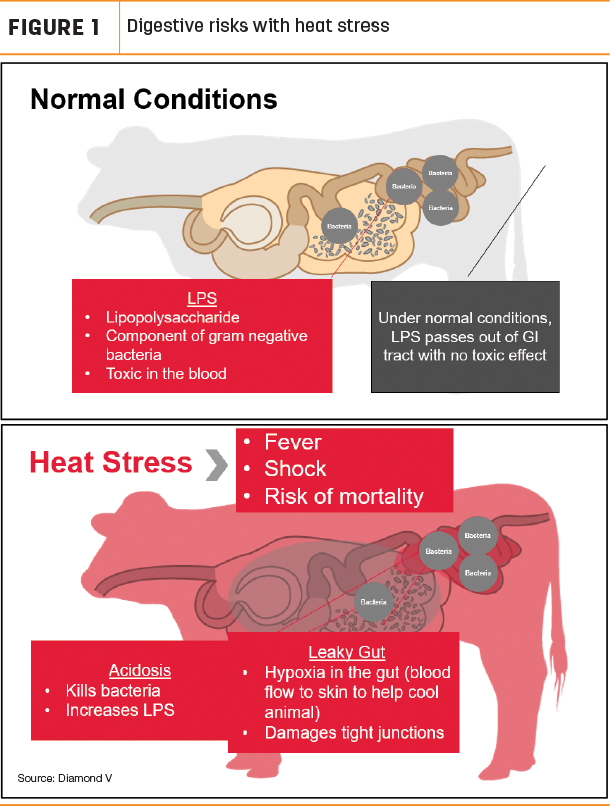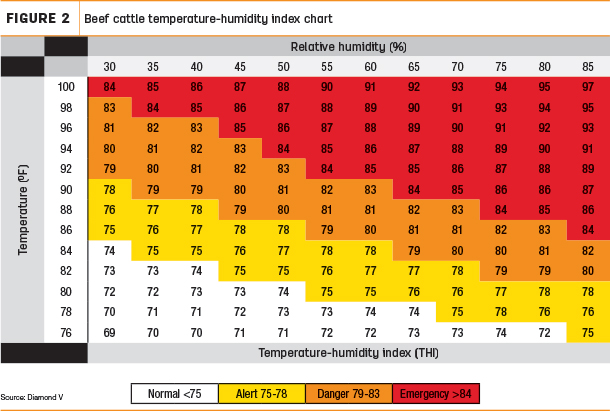The full force of summer months and hot temperatures are almost upon us. With it will come heat stress, a major concern in the beef industry. Heat stress can cause countless problems in cattle, such as a decrease in feed intake, changes in the rumen which lead to diminished digestibility and a significant negative impact on performance. The time is now to take action in your feedlot.
When it comes to heat stress, our main concerns are loss of performance and dead cattle. When we get into severe heat events, it is not uncommon for a feedyard to lose numerous animals. This is more prominent when we get an extended stretch of high heat and humidity without night cooling.
Increased energy needs
- High temperatures can cause cattle to reduce feed intake, which can negatively affect production. At the same time, the energy needed to maintain their body systems increases. Their maintenance requirements go up while their intake goes down. With this, we see increased respiration (panting), increased circulation and increased energy needs. At the same time, acidosis – which is more prominent during heat stress – has a negative effect and decreases digestibility. (See Figure 1) Cattle have greater energy needs and less energy available, which adds up to a significant loss of performance.

- LPS (lipopolysaccharide), which comes from the cell wall of specific types of naturally occurring digestive bacteria, can also be toxic. When gut bacteria die, free LPS is released into the rumen and intestinal tract. Under normal situations, this compound passes through the digestive system and is excreted by the animal without harm. However, during a heat event, the animal diverts excess blood flow to the skin and outer portion of the body in order to cool itself. As a result, blood flow to the gut is diminished, thereby sacrificing integrity of the gut lining. This results in damages to tight junctions of the intestine, often referred to as leaky gut, which then allows LPS to get into the bloodstream. In the feedlot, this can then cause fever, shock and even death.
Three things to manage heat stress
Animal comfort
- Water – Water requirements for beef cattle increase during summer months. Because cattle lose more water due to perspiration and increased respiration, extra water tanks may be needed. Keep water cool and clean to encourage them to consume more, as drinking cold water is one of the quickest ways to control and reduce body temperature. You should also make sure your water supply lines can keep up with the increased demand. While we’re on the topic of water, wetting down pen surfaces can provide a cooler surface for the animals to lay on. If you don’t have access to a sprinkler, laying down a light-colored bedding, such as straw or corn stover, can help to decrease pen floor temperatures due to decreased solar heat gain. Water will be vital this summer, so begin to act now.
- Air flow/shade – Increasing air flow can help cattle cope with extreme heat. Although no one can influence wind speed, you can increase your animals’ exposure to wind and air movement. How? Remove wind barriers such as equipment, weeds, hay bales and tall vegetation. Keep in mind, cattle that are near harvest are more susceptible to heat stress. They may need to be moved to pens with better air flow. Also, make sure you are providing proper shade. Shade is critical, especially for dark-hided cattle.
- Flies – Flies can be a huge hassle for both pasture and feedlot cattle. Stable flies, house flies, horn flies and face flies can all have a huge impact on animal performance. Biting flies can cause cattle to congregate in one area, which will reduce air flow. If cattle have to swat at flies, that’s extra energy being used and heat that’s produced. Take action to control these pesky critters by removing fly breeding areas and considering the use of other technologies to help reduce fly populations.
Diet changes
- Be sure to adjust cattle diets to help decrease heat fermentation. We want to make sure we don’t get ahead of these animals because intakes will back off. Pull cattle back a bit on what is being offered to them. Lowering the energy content of the diet may lower the heat load on cattle. Consult with your nutritionist for best practices and guidance.
- When it comes to diet changes, it’s also important to incorporate a digestive and immune support feed additive. Some digestive and immune support products can help stabilize the rumen, enhance microbiome populations, support gut integrity and maintain intake and digestion – getting more energy available to the animal. Feeding a product like this continuously through the summer months can help support cattle health and performance through stressful periods such as heat stress.
- Sometimes during heat stress, we will also see feedyards providing tubs that contain a fermentation-based feed additive. Throughout hot summer months, feed intake is likely to drop off at the bunk. However, animals will go lick these tubs and get simple sugars and other nutrients from them. This causes cattle to salivate, which is a natural buffer and helps safeguard the rumen, thereby helping reduce LPS load while encouraging consistent intake and optimum digestibility.
Plan ahead
- The last tip is to plan ahead. Don’t wait until the heat of the summer months is here. Start planning – now. Figure out what management strategies you plan to employ and which products you are going to use. As we know, heat hits differently in different parts of the country. The Cattle Temperature Humidity Index Chart (Figure 2) will help to determine the risk level as summer heat approaches.

In conclusion
As temperatures continue to rise, so do concerns in regards to cattle. Heat stress can cause changes in the rumen that lead to reduced intake and decreased digestibility and performance. By following these tips listed above and best management practices, cattle feeders can help prevent mortality and continuously support health and performance. The time is now to take appropriate action and beat the heat.








